Tibetan Medicine
- by Catherine
- Last Updated: 2023-10-02
Tibetan medicine is a kind of traditional medicine spread in Tibetan areas. It diagnoses diseases by basic methods such as pulse diagnosis and urine analysis. It uses behaviors and dietary adjustments, as well as medicinal made of natural materials (Tibetan herbs and minerals, etc.) and therapies (Tibetan acupuncture, moxibustion, etc.) to treat diseases. In traditional Tibetan medicine, there are three basic methods of diagnosis: bloodletting, fire therapy, and rubbing therapy.
Tibetan medicine believes in the basic doctrine of Buddhism that all diseases are caused by the three poisons of greed, aversion, and delusion. Following the Buddha's Four Noble Truths, Tibetan medicine use medicine to fight greed, aversion, and delusion in order to avoid suffering. Today, it learns from and integrates with many advanced medical systems, and will better serve the health of the Tibetan people and the people of the world.
Origin
In the 7th century. Songtsan Gambo invited doctors from China(Tang Dynasty), India, Central Asia, Rome, and Persia to Tibet and absorbed the excellent medical culture. At the end of the 8th century, more physicians were invited, while the doctrines of Buddhism in medicine were brought from India to Tibet. During the 11th and 12th centuries, many Indian medical documents were widely distributed to Tibet and translated into Tibetan. Subsequently, a large number of Indian Buddhist medical practices based on medical anatomy were introduced to Tibet. Till today, Tibetan medicine, based on Indian Buddhist literature and Ayurvedic traditional medicine, still exists and develops in Tibet, India, Nepal, Bhutan, Ladakh, Siberia, Mainland China, and Mongolia.
Main Tibetan Medicine Theory
1. According to Tibetan medical theory, there are three principles of function (three major factors) in the human body, namely Loong, Tree-pa, and Pay-genn and seven material bases as well as three excretions. The three principles of function dominate and control the movement of the seven material bases and the three types of excreta. Under normal conditions, the three major factors maintain balance and play the role of dominating and controlling the normal physiological activities of the human body. Once the three major factors are out of balance, it will cause diseases in the human body. With the changes of the three factors, the types of diseases, location, and severity are also different. In this case, the three major factors play the role of pathological mechanisms. Through the function of Loong, blood circulates to the whole body. If there is blood without the function of Loong, the blood will stop flowing without power. If there is Loong without blood, the body will dry up. When the blood and loong are exhausted, the body would be lifeless.
- Three principles of function:
- Loong is the source of the body's ability to circulate physical substances (e.g.blood), energy(e.g. nervous system impulses), and the non-physical (e.g.thoughts).
- Tree-pa is characterized by heat and is the source of many functions such as thermoregulation, metabolism, liver function, and discriminating intellect.
- Pay-genn is characterized by cold and is the source of many functions such as aspects of digestion, the maintenance of our physical structure, joint health, and mental stability.
- Seven material bases: Nutritional elements in the diet, blood, flesh, fat, bone, bone marrow, and semen
- Three excretions: Feces, Urine, Sweat.
2. Tibetan medicine concatenates the Wuxing (Chinese philosophy, also known as the Five Elements.) theory of traditional Chinese medicine to explain the human body, physiology, pathology, and their relationship with the external environment, and make a dialectical approach to treatment. The Five Elements theory is mainly used in pulse diagnosis, while in other aspects, the Five Sources theory is mainly used in Tibetan medicine. As early as the end of the 8th century, Tibetan medicine learned from the "Moon King Medicine Diagnosis" compiled by traditional Chinese medicine. The related theory was elaborated and developed in the classic Tibetan medicine "Four Medical Codes".
Tibetan medicine links the Zang-fu organs and pulses with the Five Elements in pulse diagnosis. The Zang-fu organs are functional entities stipulated by Traditional Chinese medicine. Each Zang is paired with a fu, and each pair is assigned to one of the Five Elements. In the springtime, the Five Elements belong to Wood, and the pulse is thin and tight; In the summertime, the Five Elements belong to Fire, and the pulse is long; In the autumn time, the Five Elements belong to Metal, the pulse is quick; In the wintertime, he Five Elements belong to Water, the pulse is weak; In the remaining period, the Five Elements belongs to Earth (18 days in each of the above season, a total of 72 days formed the last period), and the pulse is soft and short.

3. Tibetan medical theory believes that drugs are not only related to five elements(drugs' nature, taste, and efficacy also originate from the five elements) but also to Five Resources. Find Resources are the origins of the growth of all things including Earth, Water, Fire, Wind, and Air. The medicine's property of nature, taste, and efficacy also originate from the Five Sources. Earth is the source of biological growth; Water is the moisture; Fire is the heat source; Wind is the power of growth; Air is the space for living things to grow. Without one of the five sources, the creature cannot grow. This explains the unified relationship between plant elements' growth and the natural environment. Each medicinal material has a fixed property of nature, taste, and efficacy.
Tibetan medicine is also used clinically according to the six-flavor, eight-nature, and seventeen-effect compatibility of the drug. Six-flavor is sweet, sour, salty, bitter, spicy, and astringent, which have different effects on the treatment of disease. The eight-nature is heavy, moist, cold, blunt, light, rough, heat, and sharp. The seventeen effects refer to the seventeen effects of medicinal. Counter-treatment is a pair-wise confrontation, the opposite nature, one is medicine and the other is the disease. For example, cold diseases are treated with drugs of a hot nature and heat diseases are treated with drugs of a cold nature.
Main Tibetan Herbal Medicine And Others
According to relevant statistics, there are about 3,000 kinds of Tibetan medicine in China. Tibet is the birthplace of Tibetan medicine, and there are more than 360 kinds of commonly used Tibetan medicines, mainly derived from plants such as Compositae, Leguminosae, Ranunculaceae, Papaveraceae, Umbelliferae, Gentianaceae, Rosaceae, Scrophulariaceae, Cruciferae, and Liliaceae. The important medicinal genera are artemisia, corydalis, primrose, and horsetail, etc. Due to the unique climate, environment and altitude of the Tibetan plateau, Tibetan medicine uses many local species, such as saffron and Cordyceps Sinensis, etc. In addition to herbs, accessories made of yak bones, such as bracelets, are thought to help the body balance energy. These Tibetan medicine bracelets inlaid with coral and turquoise or with minerals such as metal, copper, silver, and brass may alleviate anxiety, calm the nerves, or help promote healthy blood flow and circulation.

Conclusion
Tibetan medicine is a unique and complete medical discipline system that absorbed the medical knowledge and culture of traditional Chinese medicine, Indian medicine, and Arabian medicine. It's based on the knowledge of folk medicine on the plateau and influenced by Buddhist theories and gradually developed and perfected through long-term practice.
With the features of a long history, unique theory, and rich content, Tibetan medicine is a traditional and complete science system, which is second only to traditional Chinese medical science. It has made important contributions to the health and prosperity of Tibetan people for thousands of years. On May 20, 2006, Tibetan medicinal was included in the first batch of national intangible cultural heritage.
Related Articles
- Gurla Mandhata
- Top 10 Demonic Deities in Tibetan Buddhism
- Milarepa’s Meditation Cave
- Handmade Tibetan Incense - Representative of Tibetan Culture
- Tibetan Handicrafts
- Lhasa Hotel
- India to Tibet Tours
- Tibetan Culture
- Qugu Monastery
- Dorje Drak Monastery
Email response within 0.5~24 hours.


